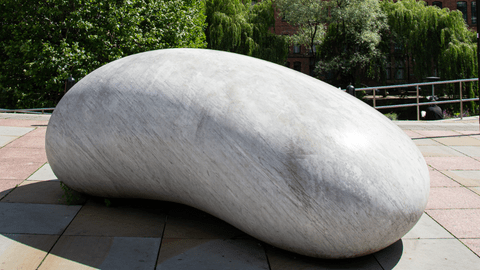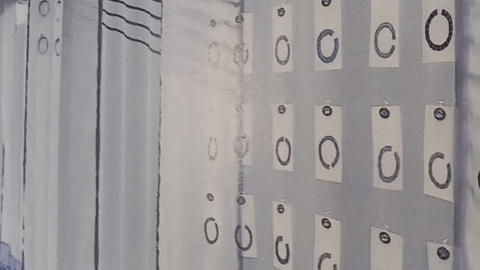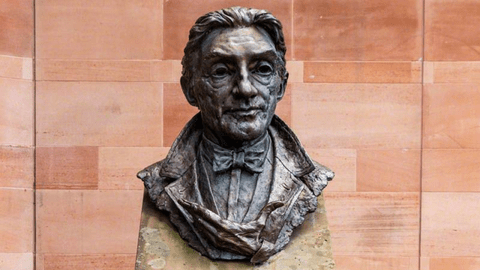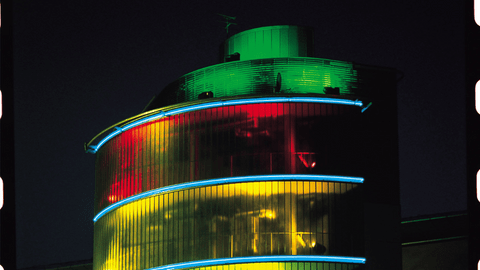Alongside its world-class music, The Bridgewater Hall has been shaped by a series of striking site-specific artworks. Some, like Kan Yasuda’s serene Touchstone or Deryck Healey’s flowing Visual Poem, remain an integral part of the building’s atmosphere today. Others, such as Kate Egan’s cosmic-inspired Space Pieces, once transformed the windows of the Hall before their removal in 2005. Together – past and present – these works reveal how art has always been woven into the life of the Hall, inviting visitors to see, as well as hear, in new and unexpected ways.

Kan Yasuda: Ishinki - Touchstone
On Barbirolli Square, poised above the canal basin, Kan Yasuda’s Ishinki – Touchstone anchors the public space outside The Bridgewater Hall. Carved from Carrara marble in Pietrasanta, Italy, the monumental yet seemingly weightless form reflects Yasuda’s mastery in balancing simplicity, texture, and light. Conceived in dialogue with its surroundings, it invites quiet contemplation amid the movement of the city, and, according to local legend, may even bring luck to those who touch it.

Deryck Healey: Visual Poem
Suspended beneath the angular roof of the foyer, Deryck Healey’s Visual Poem is a sweeping 20-metre ribbon of steel, inspired by Manchester’s textile heritage. Painted on its reverse in flashes of red, yellow, and blue, it transforms as visitors move around it, revealing bursts of colour and casting colourful reflections on the wall. Designed in harmony with the Hall’s architecture and to evolve with changing light through the seasons, it offers a shifting visual counterpoint to the musical experiences below.

Kate Egan: Space Pieces
In the early years of The Bridgewater Hall, Kate Egan’s Space Pieces filled the glass expanses of the Barbirolli and Charles Hallé rooms with vast, transparent textiles inspired by the cosmos. Bold enough to command the space yet delicate in their woven plastic mesh, they drew on imagery from planetary orbits and star fields, and even carried echoes of musical rhythm. Motorised tracks allowed the layers to glide apart, revealing shifting constellations of colour, texture, and light. Removed in 2005 due to unavoidable material soiling, they remain a much-missed element of the Hall’s early identity.

Byron Howard: Bust of Sir John Barbirolli
Greeting visitors at the entrance, Byron Howard’s bronze bust of Sir John Barbirolli stands three times life-size on a pink sandstone plinth. The Hallé Orchestra’s longest-serving conductor, Barbirolli led the ensemble for nearly three decades, guiding it through a post-war renaissance remembered as its golden age. The bust is a fitting welcome to the Hall that now carries the orchestra’s sound into the future.

Jonathan Speirs Associates: The Tower of Time
Rising beside The Bridgewater Hall, the Tower of Time was no ordinary technical plant tower. Conceived in 1996 as part of the building’s original design, its purpose was purely practical – housing the hall’s technical equipment – but its presence was transformed into something far more imaginative: a luminous, abstract clock that told time not with numbers, but with light.
